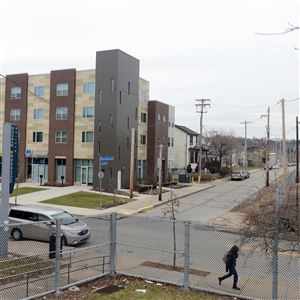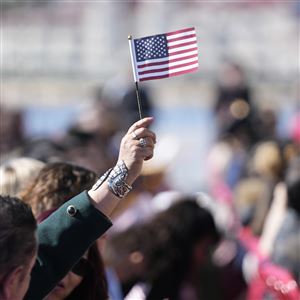Three years ago, Freddy Jarvik, a self-proclaimed Census nerd, ticked a new box on the nationwide survey: “married.”
For the first time, he could report on the decennial census that he lives in the same household in Brookline as his husband, Rob Russell. The couple married in 2018 and have been together since 2009.
The 2020 Census included a first-ever category for same-sex spouses, and according to recently released results, more than 21,000 married couples in Pennsylvania are same sex.
As the Census produces more inclusive data, Pittsburgh couples and experts say the numbers are a step forward, but there’s more work ahead to accurately represent the country’s diverse LGBTQ+ population.
“It’s progress, but there's so much more to sexuality and gender identity now that it seems almost archaic,” Mr. Jarvik said.
There were 1.2 million same-sex couples living together in the U.S. in 2020. Of all coupled households, 0.5% are same-sex spouses, according to the recent data. Pennsylvania trended slightly down from the national numbers, with 0.4% of its coupled households being same-sex married partners.
Attorney Kathleen Schneider said she’s surprised the numbers are that low, but she’s happy the government recognizes the need to collect information on same-sex spouses the way it does with opposite sex partners.
Her Regent Square law office has prided itself on assisting couples of all backgrounds for over 25 years, including LGBTQ+ families, on family law, tax, business and estate planning.
When it comes to the decision to get married, her LGBTQ+ clients have always faced different considerations, she said. For those who grew accustomed to unmarried partnership, the decision can come down to being able to earn the same benefits as straight spouses – something same sex couples were deprived of.
Massachusetts was the first state in 2004 to allow same-sex marriage. Pennsylvania wouldn’t legally recognize same-sex marriage until 10 years later, in May 2014, when a federal judge overturned a 1996 statutory ban. The following year, June 26, 2015, the U.S. Supreme Court made same-sex marriage legal across the country.
“That looms large in many older couples,” she said. “They couldn't get married for the longest time, and they're not really sure at this point whether they should or not, and what does that mean to them? Because they learned to live their lives as a couple without getting married.”
Conversations with clients, according to Ms. Schneider, can range from Medicaid eligibility to hospital visitation rights to becoming beneficiaries on one another’s retirement plans and life insurance — ensuring the surviving partner isn't burdened by Pennsylvania's 15% inheritance tax or that unaccepting families won’t leave the partner out. Straight couples rarely ever come to her office with such considerations in mind, Ms. Schneider said.
“They’re not talking about how that's going to affect their income taxes or their eligibility for government benefits,” she said.
While the choice to get married remains a complex one, the new numbers indicate that same-sex couples are more likely to be married than opposite-sex couples. For 2020 coupled households, there were significantly more opposite-sex married partners, 45.9% than unmarried partners, 6.5%. For same-sex couples, the gap was much narrower, with 0.5% married and 0.4% unmarried.
And of Pennsylvania’s coupled households, the proportion of same-sex married partners to unmarried partners was equal: 0.4%.
In addition to providing comprehensive insights into changing family dynamics in the U.S., the data collected by the decennial census play a significant role in government spending. In the 2021 fiscal year, the decennial census guided the spending of over $2.8 trillion in federal funding. The data also helps govern funding across 100-plus programs, including Medicaid, Head Start, block grant programs for community mental health services and SNAP.
For these reasons, Ms. Schneider said the new counts of same-sex spouses are a long overdue addition to the survey.
“I think it's an important piece of data that the country needs to know, and for lots and lots of reasons — health care, social services, laws in general,” she said. “Legislators need to know this. From a governance perspective, I think they need to understand what part of their constituency identifies as being one of those groups, and that way they can address their efforts accordingly.”
Making it right
Carnegie Mellon University professor Lowell Taylor, who co-authored the first paper about gay and lesbian data to appear in the academic journal “Demography” in 2000, said the Census’ history of tracking LGBTQ+ data began more than 30 years ago.
The change happened “by accident,” he said, when the 1990 Census created the relationship category “unmarried partner” for respondents to describe their household relationships.
As a result, Mr. Taylor said there was an unproportional amount of same-sex people living together who checked “unmarried partner.” From this, Mr. Taylor and his colleagues were able to extract data on same-sex unmarried partners in the same household to estimate national gay and lesbian demographics.
They used the Census to study several variables, such as the number of same-sex couples with children or the amount of gay and lesbian individuals in military service.
Still, there were flaws in the data. If two people of the same sex in one household said they were married in the 1990 Census, the Census Bureau edited the data in a significant way.
“If you were same sex, and you counted yourselves as being married, they considered that to be a logical contradiction, and they changed the sex of one of the people,” Mr. Taylor said.
He said future versions of the Census further impeded the ability to track demography because of anti-GBTQ+ legislation, such as the Defense of Marriage Act of 1996, which banned federal recognition of same-sex marriage.
Then came 2010. If a household indicated it had a same-sex married couple, the Census changed that status to "unmarried" because same-sex marriages didn’t become legal in all 50 states until 2015.
The 2020 Census’ new category for same-sex spouses addresses those past inconsistencies, helping to safeguard the data from such interference in the future.
“2020 data finally makes these corrections to the Census that have been there since 1990,” Mr. Taylor said. “Thirty years later, this is the right way to do it.”
But to researchers like Mr. Taylor, and community members like Mr. Jarvik, the Census can do more for inclusive data collection, including asking more specific questions about people’s gender and sexual orientation.
The Census Bureau, as of 2021, now asks questions about sexual orientation and gender identity in its Household Pulse Survey. Mr. Jarvik said the decennial survey should collect that kind of information, too.
“The questions they asked about race are so detailed,” Mr. Jarvik said. “They could ask similar questions about how you identify to actually get real data and statistics about people as they live. How do you identify as an individual? How do you identify as a couple?”
Staff writer Michael Korsh contributed.
First Published: July 1, 2023, 9:30 a.m.
Updated: July 2, 2023, 2:09 a.m.





